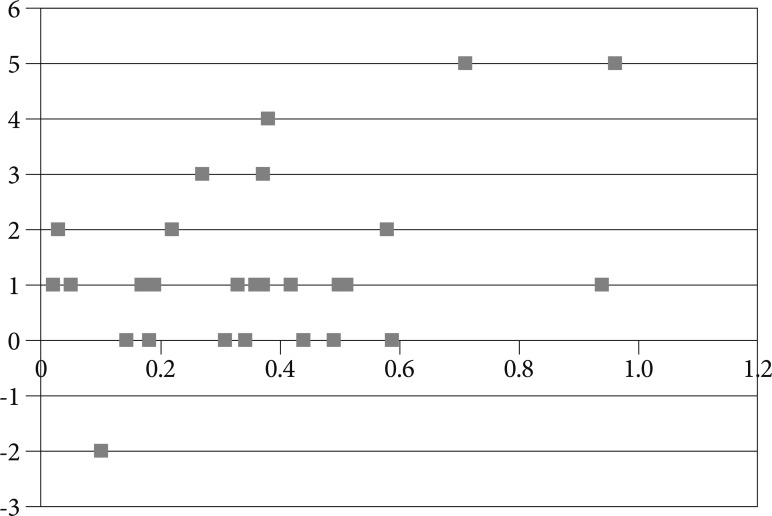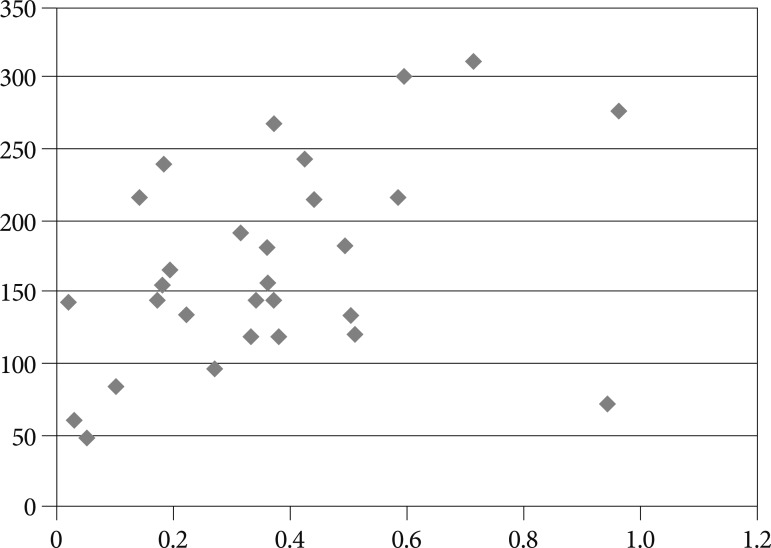J Korean Neurosurg Soc.
2012 Sep;52(3):172-178.
Angiographic Features and Clinical Outcomes of Intra-Arterial Nimodipine Injection in Patients with Subarachnoid Hemorrhage-Induced Vasospasm
- Affiliations
-
- 1Department of Neurosurgery, Korea University Medical Center, Korea University College of Medicine, Seoul, Korea. doctorns@korea.com
Abstract
OBJECTIVE
The aim of this study was to determine the role of intra-arterial (IA) nimodipine injections for cerebral vasospasm secondary to ruptured subarachnoid hemorrhage (SAH) and to investigate the factors that influence vasodilation and clinical outcomes.
METHODS
We enrolled 29 patients who underwent aneurysm clipping for ruptured cerebral aneurysms between 2009 and 2011, and who received IA nimodipine after subsequently presenting with symptomatic vasospasm. The degree of vasodilation shown in angiography was measured, and the correlation between the degree of vasodilation and both the interval from SAH to cerebral vasospasm and the interval from clipping to cerebral vasospasm was determined. The change in blood flow rate after IA injection was assessed by transcranial Doppler ultrasound. Multiple clinical parameters were completed before and after IA nimodipine injection to evaluate any improvements in clinical symptoms.
RESULTS
For eight patients, Glasgow Coma Scale (GCS) scores increased by two or more points. The regression analysis demonstrated a positive correlation between the change in GCS scores after IA nimodipine injection and the change in blood vessel diameter (p=0.025). A positive correlation was also observed between the interval from SAH to vasospasm and the change in diameter (p=0.040); and the interval from clipping to vasospasm and the change in diameter (p=0.022).
CONCLUSION
IA nimodipine injection for SAH-induced vasospasm led to significant vasodilation in angiography and improvement in clinical symptoms without significant complications. Our findings suggest that IA nimodipine injection should be utilized when intractable vasospasm develops despite rigorous conservative management.
Keyword
MeSH Terms
Figure
Reference
-
1. Biondi A, Ricciardi GK, Puybasset L, Abdennour L, Longo M, Chiras J, et al. Intra-arterial nimodipine for the treatment of symptomatic cerebral vasospasm after aneurysmal subarachnoid hemorrhage : preliminary results. AJNR Am J Neuroradiol. 2004; 25:1067–1076. PMID: 15205150.2. Böker DK, Solymosi L, Wassmann H. Immediate postangiographic intraarterial treatment of cerebral vasospasm after subarachnoid hemorrhage with nimodipine. Report on 3 cases. Neurochirurgia (Stuttg). 1985; 28(Suppl 1):118–120. PMID: 4010867.
Article3. Bracard S, Arrue P, Barral FG, Bouquigny F, Berge J, Bonneville J, et al. [Management of vasospasm from subarachnoid hemorrhage. Attitude of French centers. French Society of Neuroradiology]. J Neuroradiol. 1999; 26:S44–S47. PMID: 10363452.4. Broderick JP, Brott TG, Duldner JE, Tomsick T, Leach A. Initial and recurrent bleeding are the major causes of death following subarachnoid hemorrhage. Stroke. 1994; 25:1342–1347. PMID: 8023347.
Article5. Chou SH, Smith EE, Badjatia N, Nogueira RG, Sims JR 2nd, Ogilvy CS, et al. A randomized, double-blind, placebo-controlled pilot study of simvastatin in aneurysmal subarachnoid hemorrhage. Stroke. 2008; 39:2891–2893. PMID: 18658043.
Article6. Clouston JE, Numaguchi Y, Zoarski GH, Aldrich EF, Simard JM, Zitnay KM. Intraarterial papaverine infusion for cerebral vasospasm after subarachnoid hemorrhage. AJNR Am J Neuroradiol. 1995; 16:27–38. PMID: 7900600.7. Dion JE, Duckwiler GR, Viñuela F, Martin N, Bentson J. Pre-operative micro-angioplasty of refractory vasospasm secondary to subarachnoid hemorrhage. Neuroradiology. 1990; 32:232–236. PMID: 2145526.
Article8. Elliott JP, Newell DW, Lam DJ, Eskridge JM, Douville CM, Le Roux PD, et al. Comparison of balloon angioplasty and papaverine infusion for the treatment of vasospasm following aneurysmal subarachnoid hemorrhage. J Neurosurg. 1998; 88:277–284. PMID: 9452236.
Article9. Findlay JM, Macdonald RL, Weir BK. Current concepts of pathophysiology and management of cerebral vasospasm following aneurysmal subarachnoid hemorrhage. Cerebrovasc Brain Metab Rev. 1991; 3:336–361. PMID: 1772740.10. Grotenhuis JA, Bettag W, Fiebach BJ, Dabir K. Intracarotid slow bolus injection of nimodipine during angiography for treatment of cerebral vasospasm after SAH. A preliminary report. J Neurosurg. 1984; 61:231–240. PMID: 6737047.
Article11. Hui C, Lau KP. Efficacy of intra-arterial nimodipine in the treatment of cerebral vasospasm complicating subarachnoid haemorrhage. Clin Radiol. 2005; 60:1030–1036. PMID: 16124986.
Article12. Kassell NF, Helm G, Simmons N, Phillips CD, Cail WS. Treatment of cerebral vasospasm with intra-arterial papaverine. J Neurosurg. 1992; 77:848–852. PMID: 1432125.
Article13. Leeds NE, Taveras JM. Changes in local circulation time in frontal and parietal tumours studied by rapid serial angiography. Acta Radiol (Diagn). 1963; 1:332–342.
Article14. Livingston K, Guterman LR, Hopkins LN. Intraarterial papaverine as an adjunct to transluminal angioplasty for vasospasm induced by subarachnoid hemorrhage. AJNR Am J Neuroradiol. 1993; 14:346–347. PMID: 8456709.15. Mathis JM, DeNardo AJ, Thibault L, Jensen ME, Savory J, Dion JE. In vitro evaluation of papaverine hydrochloride incompatibilities : a simulation of intraarterial infusion for cerebral vasospasm. AJNR Am J Neuroradiol. 1994; 15:1665–1670. PMID: 7847210.16. Meyer FB. Calcium antagonists and vasospasm. Neurosurg Clin N Am. 1990; 1:367–376. PMID: 2136149.
Article17. Numaguchi Y, Zoarski GH, Clouston JE, Zagardo MT, Simard JM, Aldrich EF, et al. Repeat intra-arterial papaverine for recurrent cerebral vasospasm after subarachnoid haemorrhage. Neuroradiology. 1997; 39:751–759. PMID: 9351116.
Article18. Pickard JD, Walker V, Vile J, Perry S, Smythe PJ, Hunt R. Oral nimodipine reduces prostaglandin and thromboxane production by arteries chronically exposed to a periarterial haematoma and the antifibrinolytic agent tranexamic acid. J Neurol Neurosurg Psychiatry. 1987; 50:727–731. PMID: 3475405.
Article19. Polin RS, Coenen VA, Hansen CA, Shin P, Baskaya MK, Nanda A, et al. Efficacy of transluminal angioplasty for the management of symptomatic cerebral vasospasm following aneurysmal subarachnoid hemorrhage. J Neurosurg. 2000; 92:284–290. PMID: 10659016.
Article20. Polin RS, Hansen CA, German P, Chadduck JB, Kassell NF. Intra-arterially administered papaverine for the treatment of symptomatic cerebral vasospasm. Neurosurgery. 1998; 42:1256–1264. discussion 1264-1267. PMID: 9632183.
Article21. Rasmussen G, Bergholdt B, Dalh B, Sunde N, Cold G, Voldby B. Effect of nimodipine on cerebral blood flow and cerebrovascular reactivity after subarachnoid haemorrhage. Acta Neurol Scand. 1999; 99:182–186. PMID: 10100962.
Article22. Rinkel GJ, Feigin VL, Algra A, van Gijn J. Circulatory volume expansion therapy for aneurysmal subarachnoid haemorrhage. Cochrane Database Syst Rev. 2004; CD000483. PMID: 15494997.
Article23. Roda JM, Carceller F, Díez-Tejedor E, Avendaño C. Reduction of infarct size by intra-arterial nimodipine administered at reperfusion in a rat model of partially reversible brain focal ischemia. Stroke. 1995; 26:1888–1892. PMID: 7570744.
Article24. Rosenwasser RH, Armonda RA, Thomas JE, Benitez RP, Gannon PM, Harrop J. Therapeutic modalities for the management of cerebral vasospasm : timing of endovascular options. Neurosurgery. 1999; 44:975–979. discussion 979-980. PMID: 10232530.
Article25. Schuknecht B, Fandino J, Yüksel C, Yonekawa Y, Valavanis A. Endovascular treatment of cerebral vasospasm : assessment of treatment effect by cerebral angiography and transcranial colour Doppler sonography. Neuroradiology. 1999; 41:453–462. PMID: 10426225.
Article26. Song JK, Elliott JP, Eskridge JM. Neuroradiologic diagnosis and treatment of vasospasm. Neuroimaging Clin N Am. 1997; 7:819–835. PMID: 9336501.
- Full Text Links
- Actions
-
Cited
- CITED
-
- Close
- Share
- Similar articles
-
- Intra-arterial Nimodipine for the Treatment of Symptomatic Cerebral Vasospasm after Aneurysmal Subarachnoid Hemorrhage : Preliminary Report Clinical Research
- Effect of Intra-Arterial Nimodipine Infusion for the Treatment of Symptomatic Cerebral Vasospasm Following an Aneurysmal Subarachnoid Hemorrhage
- Contralateral Intraparenchymal Hemorrhage Following Aneurysmal Clipping
- Effects of Intravenous Administration of Nimodipine on Cerebral Pial Vessels after Experimental Subarachnoid Hemorrhage in Rabbits
- The Effect of Intra-Arterial Papaverine Injection in Cerebral Vasospasm






